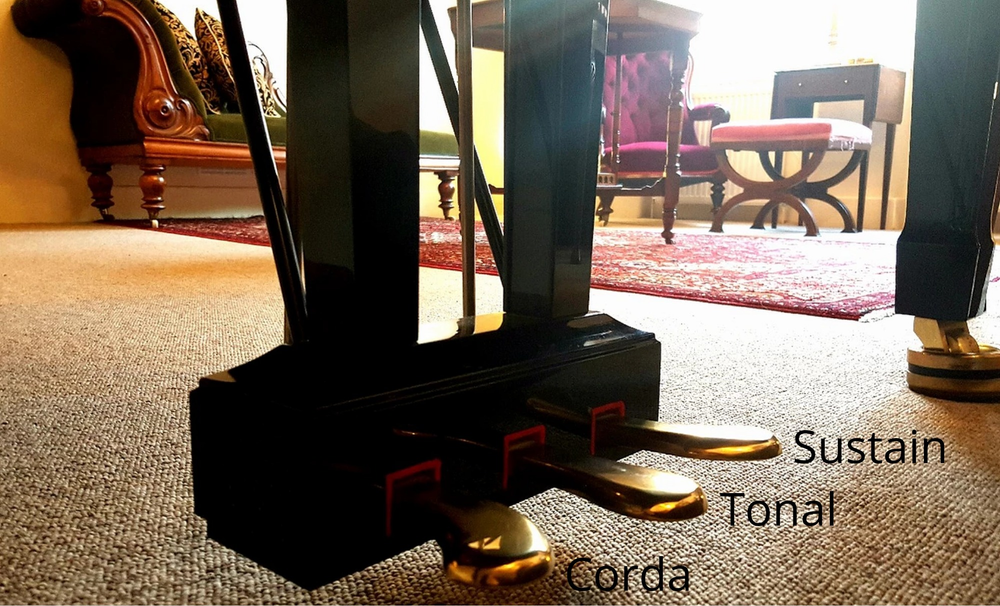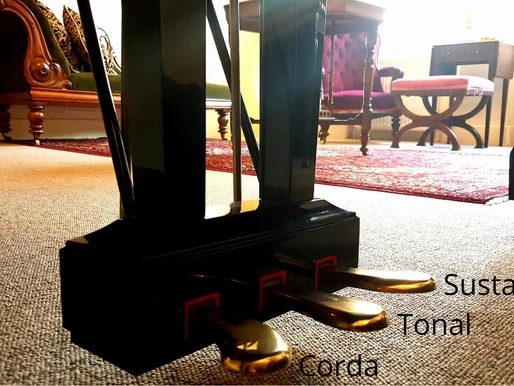Piano Lessons
Piano pedals: What do the three pedals on a piano do?
If you’re starting out using the pedal on your piano, you’ll be finding yourself becoming accustomed to a whole new method of coordinating, by the inclusion of the feet! (To this I say Sorry! As if you are at this level, you’ll no doubt have very recently started to find playing piano more of a fluid experience, ah the joys of music!)
The piano pedal has changed over the years alongside the development of the instrument, and today we are lucky to be able to use it with a level of subtlety that was not available to our Classical contemporaries.
Let’s see now what do the pedals on a piano do, and how to use them.

What do the pedals do on a piano,? What are the pedals on a piano?
There are three types of pedals on piano. Each serves a different purpose in enhancing better the sound and creating effects.
What do the 3 piano pedals do: Piano pedals names
Sustain Pedal
The sustain pedal is the most well known. It is located on the right of the pedals. Its purpose is to create echo and sound to the performance by placing away the wooden and felt bar that is located on top of the strings.
The hammer strikes the strings, and the sound projected is not stopped by this wooden-felt bar.
Also, when playing big arpeggios of open chords in which their notes are far, it helps with great resonance to support the performance by dampening those far away notes.
Corda
The Corda (Soft pedal) is located on the left of the three piano pedals. It is played with your left foot. This pedal provokes a soft but not muted sound to the performance. The mechanism within this pedal consists of forcing the hammer of the piano to hit one string instead of hitting three.
When pressing this pedal the internal mechanism shifts to the right, creating a dislocation of the keys that position the hammer to hit just one string, this hence the name: una corda
Tonal Pedal
The tonal pedal is similar to the Sustain pedal, but instead of sustaining all the sounds, it will sustain just the notes you play before pressing the pedal. The notes you’d play after wouldn’t be affected by this effect. This resulting effect is known as “pedal note”.
Other kinds of piano pedals
A pedal which you indeed wouldn’t find on most pianos is the Bassoon Pedal, which is great fun to use. It restricts the resonance of the strings with a thin bar, creating, you guessed it – a sound similar to that of the Bassoon in the lower registers
In some of the latest pianos, the middle pedal works as a “practice” pedal, which softens at maximum the sound.
How to use piano pedals?
Today, we traditionally use the pedal in syncopation with what we are playing (that is, we change the pedal as the hands go down, and not on the beat… this is a very general statement, but largely true for basic pedal phrasing).
Although we can see below some different pedals we can deliver.
Half Pedal
To deliver a “half-pedal,” the player has to press the sustain pedal just a bit.
A partial pressing is more than enough. This will create a bit of extra resonance but not too much, letting the harmony vibrate without blurring all the notes you play, if used properly.
Example of Pathetic Sonata performed by Daniel Barenboim:
Here, from min. 2:20 you can observe how Baremboin uses a half-pedal to enhance the melody, without blurring the rest of the notes.
Syncopated/Delayed Pedal
The syncopated technique of pedaling consists of pressing down the sustain pedal just after playing a note.
It is the most common technique and allows a smooth transition of notes and also provokes a very expressive and sublime effect.
Simultaneous pedal
The technique consists of playing the pedal at the same time as the note.
This creates a rhythmic effect and emphasises the notes. It is commonly used in Boogie Woogie, Jazz and Ragtime.
Piano pedals notation
On the scores, we usually find the following notation:

“Ped”: Press the pedal
” * “: Release the pedal
Here another way you can find a pedal indication:

In this case, where the peak is placed, the pedal should go up and down.
Piano pedals in early instruments
Before the instrument existed as we know it now, earlier versions of the piano would have had much less efficient dampers, making an early pedal lift essential for it to work. In addition to this, the direct pedal was also the norm (that is where the pedal and the hands go up and down together as opposed to the syncopated way we use it today).
This is why in some editions; the composer’s pedal markings might vary from what we might naturally do. So do be careful when following the pedal markings on the score!
Around the beginnings of the 19th century, we could find pianos with up to five or six pedals! Each of them added a separate effect to the instrument
Also, we have to be aware of the “close relatives” of the piano–the organ and the clavichord– which also used very similar pedal mechanism , although different techniques at the moment of playing.
Video of a demonstration Fortepiano of 1827:
In the end, pedaling will become second nature, so don’t worry if you’re being overly conscious of your foot’s actions! It will develop like a muscle, and you will probably find yourself having to reel it in! Always be conscious of the period that your piece was written in! We don’t want to be blurring any nice crisp Baroque semiquaver passages! As you know of course 🙂
Do not miss the chance to learn more about piano pedals with our post:
#wkmtteachers #pianolessonslondon #adultpianolessons #pianolessonsforbeginners #pianoteacherslondon

